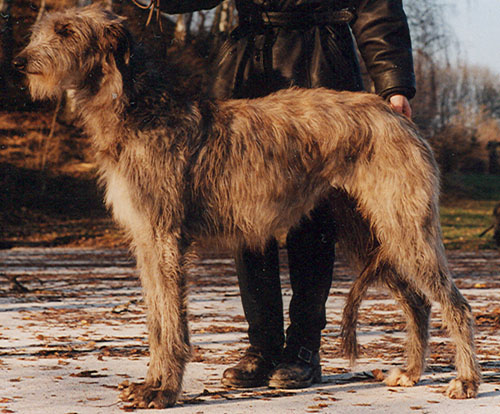Scottish Deerhound
FCI - Standard Nr. 164 a
Head: Should be broadest at the ears, narrowing slightly to
the eyes, with the muzzle tapering more decidedly to the nose. The muzzle
should be pointed, but the teeth and lips level. The head should be long,
the skull flat rather than round with a very slight rise over the eyes but
nothing approaching a stop. The hair on the skull should be moderately
long and softer than the rest of the coat. The nose should be black (in
some blue fawns-blue) and slightly aquiline. In lighter colored dogs the
black muzzle is preferable. There should be a good mustache of rather
silky hair and a fair beard. 
Head
Ears: Should be set on high; in repose, folded back like a
Greyhound's, though raised above the head in excitement without losing the
fold, and even in some cases semierect. A prick ear is bad. Big thick ears
hanging flat to the head or heavily coated with long hair are bad faults.
The ears should be soft, glossy, like a mouse's coat to the touch and the
smaller the better. There should be no long coat or long fringe, but there
is sometimes a silky, silvery coat on the body of the ear and the tip. On
all Deerhounds, irrespective of color of coat, the ears should be black or
dark colored.
Neck and Shoulders:The neck should be long-of a length befitting the Greyhound character of the dog. Extreme length is neither necessary nor desirable. Deerhounds do not stoop to their work like the Greyhounds. The mane, which every good specimen should have, sometimes detracts from the apparent length of the neck. The neck, however, must be strong as is necessary to hold a stag. The nape of the neck should be very prominent where the head is set on, and the throat clean cut at the angle and prominent. Shoulders should be well sloped; blades well back and not too much width between them. Loaded and straight shoulders are very bad faults.
Tail: Should be tolerably long, tapering and reaching to within 11/2 inches of the ground and about 11/2 inches below the hocks. Dropped perfectly down or curved when the Deerhound is still, when in motion or excited, curved, but in no instance lifted out of line of the back. It should be well covered with hair, on the inside, thick and wiry, underside longer and towards the end a slight fringe is not objectionable. A curl or ring tail is undesirable.
Eyes:Should be dark-generally dark brown, brown or hazel. A very light eye is not liked. The eye should be moderately full, with a soft look in repose, but a keen, far away look when the Deerhound is roused. Rims of eyelids should be black.
Body:General formation is that of a Greyhound of larger size and bone. Chest deep rather than broad but not too narrow or slab-sided. Good girth of chest is indicative of great lung power. The loin well arched and drooping to the tail. A straight back is not desirable, this formation being unsuited for uphill work, and very unsightly.
Legs and Feet:Legs should be broad and flat, and good broad forearms and elbows are desirable. Forelegs must, of course, be as straight as possible. Feet close and compact, with well-arranged toes. The hindquarters drooping, and as broad and powerful as possible, the hips being set wide apart. A narrow rear denotes lack of power. The stifles should be well bent. with great length from hip to hock, which should be broad and flat. Cowhocks, weak pasterns, straight stifles and splay feet are very bad faults.
Coat:The hair on the body, neck and quarters should be harsh and wiry about 3 or 4 inches long; that on the head, breast and belly much softer. There should be a slight fringe on the inside of the forelegs and hind legs but nothing approaching the "feather" of a Collie. A woolly coat is bad. Some good strains have a mixture of silky coat with the hard which is preferable to a woolly coat. The climate of the United States tends to produce the mixed coat. The ideal coat is a thick, close-lying ragged coat, harsh or crisp to the touch.
Color:Color is a matter of fancy, but the dark blue-gray is most preferred. Next come the darker and lighter grays or brindles, the darkest being generally preferred. Yellow and sandy red or red fawn, especially with black ears and muzzles, are equally high in estimation. This was the color of the oldest known strains-the McNeil and Chesthill Menzies. White is condemned by all authorities, but a white chest and white toes, occurring as they do in many of the darkest-colored dogs, are not objected to, although the less the better, for the Deerhound is a self-colored dog. A white blaze on the head, or a white collar, should entirely disqualify. The less white the better but a slight white tip to the stern occurs in some of the best strains.
Height:Height of Dogs-From 76 cm,
or even more if there be symmetry without coarseness, which is
rare.
Height of Bitches-From 71 cm upwards. There
is no objection to a bitch being large, unless too coarse, as even at her
greatest height she does not approach that of the dog, and therefore could
not be too big for work as overbig dogs are.
Weight
From 45,5 kg in dogs, and from 36,5 kg in bitches.